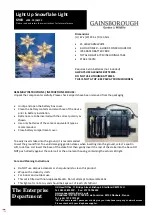
34
Subject to change without notice
trol on condition that CURSOR display is switched on by pressing
the CURSOR-MEASURE pushbutton
4
and “Cursors“ or “Cur.
Track“ has been chosen after pressing the CH1/2–CURSOR–MA/
REF–ZOOM pushbutton
15
; pushbutton lit blue.
STOP
Note: The function Cur. Track (cursor tracking) is
only available if 2 cursors are on display. The cur-
sors will then be moved simultaneously (tracking)
without changing their respective positions.
15
CH1
/
2–CURSOR–MA
/
REF–ZOOM
(pushbutton)
The function of the POSITION 1
13
, POSITION 2
14
and VOLTS/DIV
16
17
knobs can be selected if suitable operating conditions are
present (cursor measurement, mathematic signal- and refe-
rence signal display, ZOOM- and time base Search function).
Then a menu will be called by pressing this pushbutton and it
will light.
The pushbutton will signal the function activated corresponding
to the front panel labelling:
dark:
Y position and vertical sensitivity CH1 and CH2.
blue:
Y position of cursors.
green: Y position and display height of:
– Mathematics signal(s)
– Reference signal(s)
– ZOOM or time base B display of signal(s)
16
VOLTS
/
DIV–SCALE–VAR
(knob)
This knob is a multi function CH1 control.
16.1 Selection of vertical sensitivity (1-2-5 sequence)
This function is present if the CH1 VAR button
31
is not lit.
Provided VAR on pushbutton CH1 is not illuminated the sensi-
tivity will be calibrated. Turning the control CCW will decrease,
turning it CW will increase the sensitivity. 1 mV/div. to 5 V/cm can
be selected in a 1-2-5 sequence; the range is (automatic probe)
factor or (manual probe setting) dependent. The readout will
display the calibrated sensitivity (e.g. ”CH1: 5mV..“). Depending
on the sensitivity selection the signal will be shown with smaller
or greater amplitude.
STOP
Please
note:
This sensitivity selection is always active, e.g. also,
if CH2 only was chosen. In that case CH1 may be
used as trigger source.
16.2 Variable control
This function can be activated by pressing the CH1 VAR push-
button
31
and selecting On by the “Variable“ function key. The
CH1 VAR pushbutton
31
lights and indicates that the VOLTS/
DIV–SCALE–VAR knob
16
now serves as Variable control. The-
reafter the defl ection coeffi cient can be changed continuously
between 1 mV/cm and
>
5 V/cm; the range is (automatic probe)
factor or (manual probe setting) dependent and thus the signal
display height.
If uncalibrated, the defl ection coeffi cient will be displayed as
e.g. “...
>
5mV...“ and correspondingly the results of cursor
voltage measurement. In calibrated conditon e.g. “...:5mV...“
will be displayed.
If variable “off“ is activated in the CH1 menu, the defl ection
coeffi cient becomes calibrated, the CH1 VAR pushbutton
31
does not light any longer and the VOLTS/DIV–SCALE–VAR knob
16
returns to 1-2-5 sequence.
16.3 Scaling the FFT display
(digital mode only)
16.3.1
Preliminary note:
To avoid erroneous spectrum displays, it must be checked be-
fore switching over to FFT, that the Yt (time base) signal display
is suited for calculation in FFT. This means that the time base
setting (sampling rate) must enable the display of minimum one
signal period; in the case of complex signals this is regarding
the signal with the lowest frequency. On the other hand the
sampling rate must not be too low (too many signal periods)
to avoid so called aliasing. The signal display height should be
between 5 mm (0.5 div.) and 8 cm (8 div.). Signal display heights
>
8 cm, cause the danger that the dynamic range is exceeded, so
that signals deformed by limiting effects to square wave form,
become digitised and at least show spectrum displays spectra
that do not exist in reality. If the sampling rate is too low the
readout displays “ALS“; if the signal is too high “overrange ±“
will be displayed.
Such problems can be avoided, by pressing the AUTOSET push-
button
11
before switching over to FFT or during FFT mode.
16.3.2
Scaling
In FFT mode the VOLTS/DIV–SCALE–VAR knob
16
only chan-
ges the scaling of the spectrum display; this means that the
spectrum (including noise) is displayed in double height after
switching over from 20dB/cm to 10dB/cm. The Y defl ection coef-
fi cient previously selected in Yt mode is thereby not affected.
If dBV is set in the FFT menu, the scaling is switched over from
5 dB/cm to 500 dB/cm in 1-2-5 sequence by the VOLTS/DIV–SCA-
LE–VAR knob
16
; at V
(rms)
the range is from 10μV/cm to 5V/cm
also switched in 1-2-5 sequence. The scaling limits depend on
the current VOLTS/DIV settings. Please note that in contrast to
Yt and XY signal display modes, rms values are displayed, not
peak to peak values.
17
VOLTS
/
DIV–SCALE–VAR
(knob)
This multi function control belongs to CH2.
17.1 Selection of vertical sensitivity
(1-2-5 sequence)
This function is present if the CH2 VAR-pushbutton
33
is not
lit.
The sensitivity will be calibrated provided VAR on the CH2 push-
button is not illuminated. Turning the control CCW will decrease,
turning it CW will increase the sensitivity. 1 mV/div. to 5 V/cm
can be selected in a 1-2-5 sequence; the range is (automatic
probe) factor or (manual probe setting) dependent. The readout
will show the sensitivity (e.g. ”CH2:5mV..“). Depending on the
sensitivity the signal will be displayed with smaller or greater
amplitude.
C o n t r o l s a n d R e a d o u t
VOLTS / DIV
SCALE
·
VAR
VOLTS / DIV
SCALE
·
VAR
AUTO
MEASURE
5 V
1 mV
5 V
1 mV
CH 1/2
CURSOR
MA/REF
ZOOM
POSITION 1
POSITION 2
POWER
MENU
OFF
13
15
14
17
16
18















































